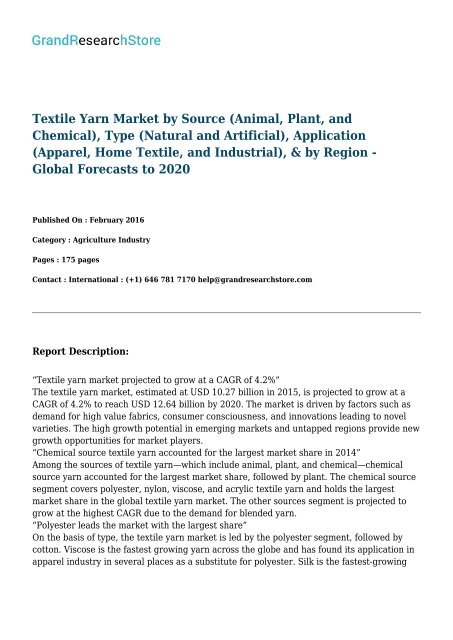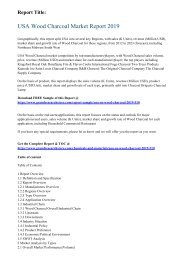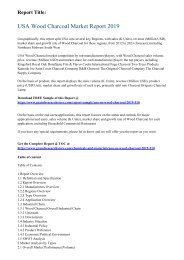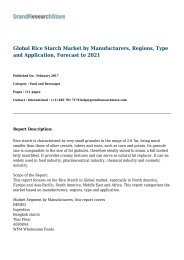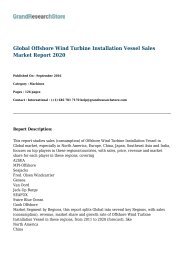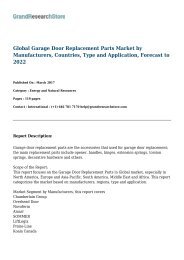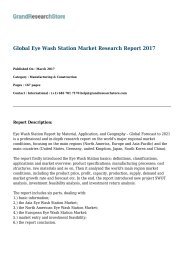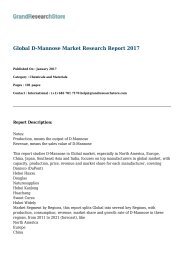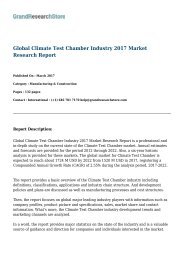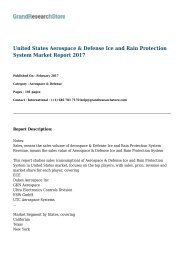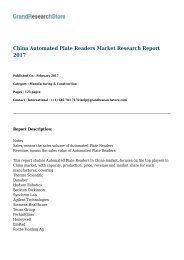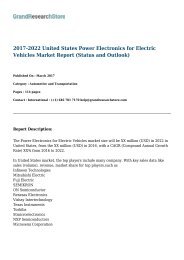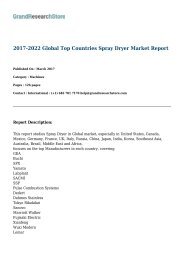Textile Yarn Market by Source (Animal, Plant, and Chemical), Type (Natural and Artificial), Application (Apparel, Home Textile, and Industrial), & by Region - Global Forecasts to 2020
This report provided by GrandResearchStore is about,The textile yarn market, estimated at USD 10.27 billion in 2015, is projected to grow at a CAGR of 4.2% to reach USD 12.64 billion by 2020. The market is driven by factors such as demand for high value fabrics, consumer consciousness, and innovations leading to novel varieties. The high growth potential in emerging markets and untapped regions provide new growth opportunities for market players.
This report provided by GrandResearchStore is about,The textile yarn market, estimated at USD 10.27 billion in 2015, is projected to grow at a CAGR of 4.2% to reach USD 12.64 billion by 2020. The market is driven by factors such as demand for high value fabrics, consumer consciousness, and innovations leading to novel varieties. The high growth potential in emerging markets and untapped regions provide new growth opportunities for market players.
Create successful ePaper yourself
Turn your PDF publications into a flip-book with our unique Google optimized e-Paper software.
<strong>Textile</strong> <strong>Yarn</strong> <strong>Market</strong> <strong>by</strong> <strong>Source</strong> (<strong>Animal</strong>, <strong>Plant</strong>, <strong>and</strong><br />
<strong>Chemical</strong>), <strong>Type</strong> (<strong>Natural</strong> <strong>and</strong> <strong>Artificial</strong>), <strong>Application</strong><br />
(<strong>Apparel</strong>, <strong>Home</strong> <strong>Textile</strong>, <strong>and</strong> <strong>Industrial</strong>), & <strong>by</strong> <strong>Region</strong> -<br />
<strong>Global</strong> <strong>Forecasts</strong> <strong>to</strong> <strong>2020</strong><br />
Published On : February 2016<br />
Category : Agriculture Industry<br />
Pages : 175 pages<br />
Contact : International : (+1) 646 781 7170 help@gr<strong>and</strong>researchs<strong>to</strong>re.com<br />
Report Description:<br />
“<strong>Textile</strong> yarn market projected <strong>to</strong> grow at a CAGR of 4.2%”<br />
The textile yarn market, estimated at USD 10.27 billion in 2015, is projected <strong>to</strong> grow at a<br />
CAGR of 4.2% <strong>to</strong> reach USD 12.64 billion <strong>by</strong> <strong>2020</strong>. The market is driven <strong>by</strong> fac<strong>to</strong>rs such as<br />
dem<strong>and</strong> for high value fabrics, consumer consciousness, <strong>and</strong> innovations leading <strong>to</strong> novel<br />
varieties. The high growth potential in emerging markets <strong>and</strong> untapped regions provide new<br />
growth opportunities for market players.<br />
“<strong>Chemical</strong> source textile yarn accounted for the largest market share in 2014”<br />
Among the sources of textile yarn—which include animal, plant, <strong>and</strong> chemical—chemical<br />
source yarn accounted for the largest market share, followed <strong>by</strong> plant. The chemical source<br />
segment covers polyester, nylon, viscose, <strong>and</strong> acrylic textile yarn <strong>and</strong> holds the largest<br />
market share in the global textile yarn market. The other sources segment is projected <strong>to</strong><br />
grow at the highest CAGR due <strong>to</strong> the dem<strong>and</strong> for blended yarn.<br />
“Polyester leads the market with the largest share”<br />
On the basis of type, the textile yarn market is led <strong>by</strong> the polyester segment, followed <strong>by</strong><br />
cot<strong>to</strong>n. Viscose is the fastest growing yarn across the globe <strong>and</strong> has found its application in<br />
apparel industry in several places as a substitute for polyester. Silk is the fastest-growing
natural yarn segment of textile yarn market, particularly in developing Asian economies due<br />
<strong>to</strong> the extensive fabric production in these countries.<br />
“China: The future of the textile yarn industry”<br />
China is focusing on increased usage of advanced technologies <strong>and</strong> newer products for<br />
textile yarn. Also the awareness among the consumers is increasing in the country;<br />
therefore the dem<strong>and</strong> for water, stain, <strong>and</strong> fire-resistant products requires specialized<br />
product development. With greater applicability of textile yarn <strong>and</strong> focus on achieving<br />
greater profits, several textile manufacturers are willing <strong>to</strong> spend on innovative blended<br />
textile yarn varieties that combine properties of natural <strong>and</strong> artificial yarn.<br />
Turkey was the largest country-level market for textile yarn in Europe, <strong>and</strong> is projected <strong>to</strong><br />
grow at the highest CAGR, in terms of volume.<br />
Break-up of Primaries:<br />
? By Company <strong>Type</strong>: Tier 1 – 50 %, Tier 2 – 30%, <strong>and</strong> Tier 3 – 20%<br />
? By Designation: C level – 28%, Direc<strong>to</strong>r level – 22%, Others – 50%<br />
? By <strong>Region</strong>: North America – 40%, Europe – 20%, Asia-Pacific – 30%, RoW – 10%<br />
Leading players such as Parkdale Mills Incorporated (U.S.), Vardhman <strong>Textile</strong>s Ltd. (India),<br />
Weiqiao <strong>Textile</strong> Company Ltd (China), Huvis Corporation (South Korea), <strong>and</strong> Grasim<br />
Industries Ltd (India) have been profiled in the report. The other players include Raymond<br />
Ltd. (India), Kairuide Holding Co. Ltd (China), Low & Bonar Plc (U.K.), Birle?ik Koyunlulular<br />
Mensucat Tic. ve San. A.?. (Turkey), <strong>and</strong> Hengli Group (China).<br />
Reasons <strong>to</strong> buy this report:<br />
• To get a comprehensive overview of the global textile yarn market<br />
• To gain wide ranging information about the <strong>to</strong>p players in this industry, their product<br />
portfolios, <strong>and</strong> key strategies adopted <strong>by</strong> them<br />
• To gain insights about the major countries/regions in which the textile yarn market is<br />
flourishing<br />
Table of contents:<br />
TABLE OF CONTENTS<br />
1 INTRODUCTION 15<br />
1.1 OBJECTIVES OF THE STUDY 15<br />
1.2 MARKET DEFINITION 15<br />
1.3 MARKETS SCOPE 16<br />
1.3.1 MARKETS COVERED 16<br />
1.3.2 YEARS CONSIDERED IN THE REPORT 17<br />
1.4 CURRENCY 18<br />
1.5 PACKAGE SIZE 18
1.6 STAKEHOLDERS 18<br />
1.7 LIMITATIONS 18<br />
2 RESEARCH METHODOLOGY 19<br />
2.1 RESEARCH DATA 20<br />
2.1.1 SECONDARY DATA 21<br />
2.1.1.1 KEY DATA FROM SECONDARY SOURCES 21<br />
2.1.2 PRIMARY DATA 22<br />
2.1.2.1 KEY DATA FROM PRIMARY SOURCES 22<br />
2.1.2.2 KEY INDUSTRY INSIGHTS 23<br />
2.1.2.3 BREAKDOWN OF PRIMARIES 24<br />
2.2 FACTOR ANALYSIS 24<br />
2.2.1 DEMAND SIDE ANALYSIS 24<br />
2.2.1.1 Rapid transformation <strong>and</strong> high profits in retail s<strong>to</strong>res across various categories 24<br />
2.2.1.2 Increased product line diversification <strong>by</strong> major textile companies 25<br />
2.2.2 SUPPLY-SIDE ANALYSIS 25<br />
2.2.2.1 Abundance in availability of raw materials of both natural <strong>and</strong> artificial yarns <strong>and</strong><br />
increasing investments 25<br />
2.2.2.2 Continuous Research & Development 25<br />
2.3 MARKET SIZE ESTIMATION 26<br />
2.3.1 BOTTOM-UP APPROACH 26<br />
2.3.2 TOP-DOWN APPROACH 26<br />
2.4 MARKET BREAKDOWN & DATA TRIANGULATION 28<br />
2.4.1 RESEARCH ASSUMPTIONS 28<br />
3 EXECUTIVE SUMMARY 29<br />
4 PREMIUM INSIGHTS 34<br />
4.1 ATTRACTIVE OPPORTUNITIES IN THE TEXTILE YARN MARKET 34<br />
4.2 TEXTILE YARN MARKET - YARN SEGMENTS 35<br />
4.3 TEXTILE YARN – CHEMICAL YARN ACCOUNTS FOR A MAJORITY MARKET SHARE 36<br />
4.4 GROWTH RATE (VOLUME), BY COUNTRY 37<br />
4.5 APPLICATION INDUSTRY GROWTH MATRIX 38<br />
4.6 LIFE CYCLE ANALYSIS, BY REGION 39<br />
5 MARKET OVERVIEW 40<br />
5.1 INTRODUCTION 40<br />
5.2 MARKET DYNAMICS 40<br />
5.2.1 DRIVERS 41<br />
5.2.1.1 Improved dem<strong>and</strong> for textile yarn across apparel, home textile, <strong>and</strong> industrial<br />
purposes 41<br />
5.2.1.2 Innovations in production process <strong>and</strong> end use industries 42<br />
5.2.2 RESTRAINTS 43<br />
5.2.2.1 Stringent rules <strong>and</strong> regulations 43<br />
5.2.2.2 Volatility in raw material prices <strong>and</strong> its availability 44<br />
5.2.3 OPPORTUNITIES 45<br />
5.2.3.1 Growing dem<strong>and</strong> for organic-based yarns 45
5.2.3.2 Development of new varieties <strong>and</strong> blends 45<br />
5.2.4 CHALLENGES 46<br />
5.2.4.1 High inven<strong>to</strong>ry holding costs 46<br />
5.2.4.2 Direct government assistance <strong>to</strong> raw material producers in developed countries 46<br />
5.2.4.3 Maintaining quality through scattered sourcing channels 46<br />
5.2.4.4 Trans-Pacific Partnership hindering growth 46<br />
6 INDUSTRY TRENDS 48<br />
6.1 INTRODUCTION 48<br />
6.2 VALUE CHAIN ANALYSIS 48<br />
6.3 SUPPLY CHAIN ANALYSIS OF TEXTILE YARN 49<br />
6.4 PORTER’S FIVE FORCES ANALYSIS 50<br />
6.4.1 THREAT OF NEW ENTRANTS 51<br />
6.4.2 THREAT OF SUBSTITUTES 51<br />
6.4.3 BARGAINING POWER OF BUYERS 51<br />
6.4.4 BARGAINING POWER OF SUPPLIERS 52<br />
6.4.5 INTENSITY OF RIVALRY 52<br />
7 TEXTILE YARN MARKET, BY SOURCE 53<br />
7.1 INTRODUCTION 54<br />
7.2 ANIMAL SOURCE 56<br />
7.3 PLANT SOURCE 58<br />
7.4 CHEMICAL SOURCE 59<br />
7.5 OTHERS 61<br />
8 TEXTILE YARN MARKET, BY TYPE 62<br />
8.1 INTRODUCTION 63<br />
8.2 NATURAL YARN 64<br />
8.2.1 ANIMAL YARN 65<br />
8.2.1.1 Silk yarn 65<br />
8.2.1.2 Wool yarn 66<br />
8.2.2 PLANT YARN 67<br />
8.2.2.1 Cot<strong>to</strong>n yarn 67<br />
8.2.2.2 Flax yarn 68<br />
8.2.2.3 Hemp yarn 69<br />
8.2.2.4 Jute yarn 70<br />
8.2.2.5 Ramie yarn 71<br />
8.3 ARTIFICIAL YARN 72<br />
8.3.1 POLYESTER 72<br />
8.3.2 NYLON 74<br />
8.3.3 ACRYLIC 75<br />
8.3.4 VISCOSE 76<br />
8.4 OTHERS 77<br />
9 TEXTILE YARN MARKET, BY APPLICATION 78<br />
9.1 INTRODUCTION 79<br />
9.2 APPAREL 81
9.3 HOME TEXTILE 82<br />
9.4 INDUSTRIAL 83<br />
9.5 OTHER APPLICATIONS 84<br />
10 TEXTILE YARN MARKET, BY REGION 86<br />
10.1 INTRODUCTION 87<br />
10.2 PEST ANALYSIS 87<br />
10.2.1 POLITICAL FACTORS 87<br />
10.2.1.1 Cost support provided <strong>by</strong> Chinese government 87<br />
10.2.1.2 Schemes <strong>to</strong> modernize spinning technologies in India 87<br />
10.2.1.3 Implementation of Free Trade Agreements 87<br />
10.2.2 ECONOMIC FACTORS 87<br />
10.2.2.1 Macroeconomic fac<strong>to</strong>rs causing volatility in commodity prices 87<br />
10.2.2.2 Fluctuating foreign exchange rates pose risk for exporters <strong>and</strong> importers 88<br />
10.2.3 SOCIAL FACTORS 88<br />
10.2.3.1 Child labor 88<br />
10.2.3.2 Workers’ rights 88<br />
10.2.3.3 Health <strong>and</strong> Safety 88<br />
10.2.3.3.1 Exposure <strong>to</strong> chemicals 88<br />
10.2.3.3.2 Exposure <strong>to</strong> noise 88<br />
10.2.3.3.3 Ergonomic issues 89<br />
10.2.3.4 <strong>Animal</strong> welfare 89<br />
10.2.4 TECHNOLOGICAL FACTORS 89<br />
10.2.4.1 R&D initiatives for production & application of textile yarn 89<br />
10.2.4.2 Advanced processing technologies used <strong>to</strong> extract textile yarn 90<br />
10.3 NORTH AMERICA 91<br />
10.3.1 U.S. 95<br />
10.3.2 CANADA 97<br />
10.3.3 MEXICO 98<br />
10.4 EUROPE 99<br />
10.4.1 TURKEY 104<br />
10.4.2 U.K. 105<br />
10.4.3 GERMANY 106<br />
10.4.4 FRANCE 107<br />
10.4.5 ITALY 108<br />
10.4.6 RUSSIAN FEDERATION 109<br />
10.4.7 ROMANIA 110<br />
10.4.8 REST OF EUROPE 111<br />
10.5 ASIA-PACIFIC 113<br />
10.5.1 CHINA 116<br />
10.5.2 INDIA 118<br />
10.5.3 PAKISTAN 119<br />
10.5.4 AUSTRALIA 121<br />
10.5.5 BANGLADESH 122
10.5.6 REST OF ASIA-PACIFIC 123<br />
10.6 REST OF THE WORLD (ROW) 124<br />
10.6.1 BRAZIL 127<br />
10.6.2 ARGENTINA 128<br />
10.6.3 IRAN 129<br />
10.6.4 CHILE 130<br />
10.6.5 EGYPT 131<br />
10.6.6 OTHERS 132<br />
11 COMPETITIVE LANDSCAPE 133<br />
11.1 OVERVIEW 133<br />
11.2 COMPETITIVE SITUATION & TRENDS 135<br />
11.2.1 ACQUISITIONS 137<br />
11.2.2 EXPANSION & INVESTMENTS 138<br />
11.2.3 JOINT VENTURE 139<br />
12 COMPANY PROFILES 140<br />
(Company at a Glance, Recent Financials, Products & Services, Strategies & Insights, &<br />
Recent Developments)*<br />
12.1 INTRODUCTION 140<br />
12.2 PARKDALE MILLS INCORPORATED 141<br />
12.3 VARDHMAN TEXTILES LIMITED 144<br />
12.4 HUVIS CORPORATION 147<br />
12.5 GRASIM INDUSTRIES LIMITED 151<br />
12.6 RAYMOND LIMITED 154<br />
12.7 WEIQIAO TEXTILE COMPANY LIMITED 157<br />
12.8 KAIRUIDE HOLDING CO. LTD 159<br />
12.9 LOW & BONAR PLC 161<br />
12.10 BIRLE?IK KOYUNLULULAR MENSUCAT TIC. VE SAN. A.?. 163<br />
12.11 HENGLI GROUP 165<br />
*Details on company at a glance, recent financials, products & services, strategies &<br />
insights, & recent developments might not be captured in case of unlisted companies.<br />
13 APPENDIX 166<br />
13.1 INSIGHTS OF INDUSTRY EXPERTS 166<br />
13.2 DISCUSSION GUIDE 167<br />
13.3 KNOWLEDGE STORE: MARKETSANDMARKETS’ SUBSCRIPTION PORTAL 169<br />
13.4 INTRODUCING RT: REAL-TIME MARKET INTELLIGENCE 171<br />
13.5 AVAILABLE CUSTOMIZATIONS 172<br />
13.6 RELATED REPORTS 173<br />
Get full report details at:<br />
http://www.gr<strong>and</strong>researchs<strong>to</strong>re.com/agriculture-industry/textile-yarn-market-b<br />
y-source-animal-plant-<strong>and</strong>-chemical-type-natural-<strong>and</strong>-artificial-applicationapparel-home-textile-<strong>and</strong>-industrial-26-<strong>by</strong>-region---global-forecasts-<strong>to</strong>-<strong>2020</strong>


